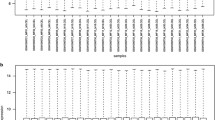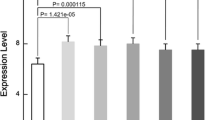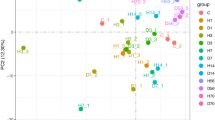Abstract
Previous studies have described alterations in gene expression following spinal cord injury, but this response to mechanical stimuli is difficult to investigate in vivo. Therefore, we have investigated the effect of cyclic tensile strain on cultured spinal cord cells from E15 Sprague–Dawley rats. Microarray analysis of gene expression and categorization of identified genes were performed using Gene Ontology (GO) and Kyoto Encyclopedia of Genes and Genomes (KEGG) systems.
The application of cyclic tensile strain reduced the viability of cultured spinal cord cells significantly in a dose- and time-dependent manner. GO analysis identified candidate genes related to “apoptosis” (44) and to “response to stimulus” (17). KEGG analysis identified changes in the expression levels of 12 genes of the mitogen-activated protein kinase (MAPK) signaling pathway, which were confirmed to be upregulated and validated by RT-PCR analysis. Spinal cord cells undergo cell death in response to cyclic tensile strain, which were dose- and time-dependent, with upregulation of various genes, in particular of the MAPK pathway.
Access this chapter
Tax calculation will be finalised at checkout
Purchases are for personal use only
Similar content being viewed by others
References
Baptiste DC, Fehlings MG (2006) Pathophysiology of cervical myelopathy. Spine J 6:190S–197S
Uchida K, Baba H, Maezawa Y et al (2003) Increased expression of neurotrophins and their receptors in the mechanically compressed spinal cord of the spinal hyperostotic mouse (twy/twy). Acta Neuropathol 106:29–36
Ghafoor AU, Martin TW, Gopalakrishnan S et al (2005) Caring for the patients with cervical spine injuries: what have we learned? J Clin Anesth 17:640–649
Uchida K, Nakajima H, Sato R et al (2009) Cervical spondylotic myelopathy associated with kyphosis or sagittal sigmoid alignment: outcome after anterior or posterior decompression. J Neurosurg Spine 11:521–528
Hayes RL, Yang K, Raghupathi R et al (1995) Changes in gene expression following traumatic brain injury in the rat. J Neurotrauma 12:779–790
Raghupathi R, McIntosh TK (1996) Regionally and temporally distinct patterns of induction of c-fos, c-jun and junB mRNAs following experimental brain injury in the rat. Brain Res Mol Brain Res 37:134–144
Sall JM, Morehead M, Murphy S et al (1996) Alterations in CNS gene expression in a rodent model of moderate traumatic brain injury complicated by acute alcohol intoxication. Exp Neurol 139:257–268
Yakovlev AG, Faden AI (1995) Molecular biology of CNS injury. J Neurotrauma 12:767–777
Carmel JB, Galante A, Soteropoulos P et al (2001) Gene expression profiling of acute spinal cord injury reveals spreading inflammatory signals and neuron loss. Physiol Genomics 7:201–213
Song G, Cechvala C, Resnick DK et al (2001) GeneChip analysis after acute spinal cord injury in rat. J Neurochem 79:804–815
Tachibana T, Noguchi K, Ruda MA (2002) Analysis of gene expression following spinal cord injury in rat using complementary DNA microarray. Neurosci Lett 327:133–137
Aimone JB, Leasure JL, Perreau VM et al (2004) Spatial and temporal gene expression profiling of the contused rat spinal cord. Exp Neurol 189:204–221
Di Giovanni S, Knoblach SM, Brandoli C et al (2003) Gene profiling in spinal cord injury shows role of cell cycle in neuronal death. Ann Neurol 53:454–468
Popovich PG, Stokes BT, Whitacre CC (1996) Concept of autoimmunity following spinal cord injury: possible roles for T lymphocytes in the traumatized central nervous system. J Neurosci Res 45:349–363
Morrison B 3rd, Saatman KE, Meaney DF et al (1998) In vitro central nervous system models of mechanically induced trauma: a review. J Neurotrauma 15:911–928
Gilbert JA, Weinhold PS, Banes AJ et al (1994) Strain profiles for circular cell culture plates containing flexible surfaces employed to mechanically deform cells in vitro. J Biomech 27:1169–1177
Matsumoto T, Kawakami M, Kuribayashi K et al (1999) Cyclic mechanical stretch stress increases the growth rate and collagen synthesis of nucleus pulposus cells in vitro. Spine (Phila Pa 1976) 24:315–319
Nakatani T, Marui T, Hitora T et al (2002) Mechanical stretching force promotes collagen synthesis by cultured cells from human ligamentum flavum via transforming growth factor-beta1. J Orthop Res 20:1380–1386
Uchida K, Nakajima H, Takamura T et al (2008) Gene expression profiles of neurotrophic factors in rat cultured spinal cord cells under cyclic tensile stress. Spine (Phila Pa 1976) 33:2596–2604
Uchida K, Nakajima H, Hirai T et al (2010) Microarray analysis of expression of cell death-associated genes in rat spinal cord cells exposed to cyclic tensile stresses in vitro. BMC Neurosci 11:84
Morrison B 3rd, Meaney DF, Margulies SS et al (2000) Dynamic mechanical stretch of organotypic brain slice cultures induces differential genomic expression: relationship to mechanical parameters. J Biomech Eng 122:224–230
Haq F, Keith C, Zhang G (2006) Neurite development in PC12 cells on flexible micro-textured substrates under cyclic stretch. Biotechnol Prog 22:133–140
Morrison B 3rd, Cater HL, Wang CC et al (2003) A tissue level tolerance criterion for living brain developed with an in vitro model of traumatic mechanical loading. Stapp Car Crash J 47:93–105
Tanoue M, Yamaga M, Ide J et al (1996) Acute stretching of peripheral nerves inhibits retrograde axonal transport. J Hand Surg Br 21:358–363
Davis RJ (1993) The mitogen-activated protein kinase signal transduction pathway. J Biol Chem 268:14553–14556
Acknowledgment
This work was supported in part by Grants-in-Aid for General Scientific Research of the Ministry of Education, Science and Culture of Japan (grants numbers 16390435, 18390411, 19791023, 21591895, and 21791389). This study was also supported by grants from Research Program of Spinal Cord Intractable Pain (2009), The Public Health Bureau of the Japanese Ministry of Health and Welfare.
Conflict of Interest All authors declare that they have no conflict of interest.
Author information
Authors and Affiliations
Corresponding author
Editor information
Editors and Affiliations
Rights and permissions
Copyright information
© 2014 Springer Japan
About this chapter
Cite this chapter
Uchida, K., Nakajima, H., Hirai, T., Roberts, S., Johnson, W.E.B., Baba, H. (2014). Microarray Analysis of Expression of Cell Death-Associated Genes in Spinal Cord Cells with Cyclic Tensile Strain. In: Uchida, K., Nakamura, M., Ozawa, H., Katoh, S., Toyama, Y. (eds) Neuroprotection and Regeneration of the Spinal Cord. Springer, Tokyo. https://doi.org/10.1007/978-4-431-54502-6_11
Download citation
DOI: https://doi.org/10.1007/978-4-431-54502-6_11
Published:
Publisher Name: Springer, Tokyo
Print ISBN: 978-4-431-54501-9
Online ISBN: 978-4-431-54502-6
eBook Packages: MedicineMedicine (R0)




